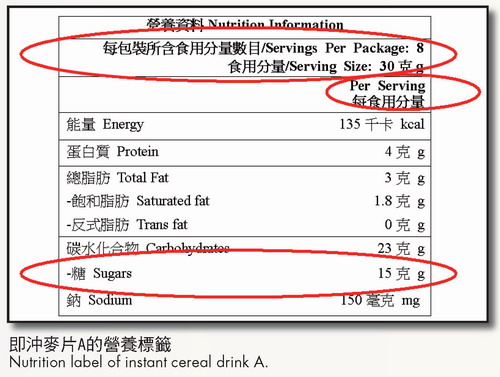
Food Safety Focus (77th Issue, December 2012) – Food Safety Platform
Check out Nutrition Label to
Reduce Sugars Intake from Breakfast Cereals
Reported by Ms. Michelle CHAN, Scientific Officer,
Risk Communication Section,
Centre for Food Safety
In the previous issues, we have illustrated the use of " three-step to use nutrition labels " (three-steps) to consume instant noodles and crispy chips more healthily. As the last issue of the series, let's see how three-steps help reduce sugars intake from breakfast cereals.
Take a Look at Sugars
Sugars are simple carbohydrates which provide energy (1g of sugars provides 4 kcal). Some sugars are naturally present in foods (e.g. fructose in fruits), while some are added to processed foods like confectionery and carbonated drinks to enrich flavour.
Getting too much sugar may lead to overweight and obesity, which in turn, increases the risk of chronic diseases including heart diseases and diabetes. Furthermore, dental caries are also associated with frequent excessive intake of sugars. The World Health Organization has set the intake goal that less than 10% of energy contribution should come from sugars added to foods during production and consumption plus natural sugars found in honey, fruit juices and syrups. In other words, for a 2000 kcal diet, intake of sugars should not exceed 50 g per day (about 10 sugar cubes).
Breakfast Cereals and Sugars
Different types of breakfast cereal products are available in the market. They can be broadly divided into the cold-served and hot-served ones. The former is ready to be consumed with milk or soy milk without further processing. The hot-served ones are usually oatmeal or instant cereal drinks that require cooking or reconstitution. Breakfast cereals are made with grains such as oat or wheat rich in carbohydrates and provide dietary fibre. Sugar or sugar containing ingredients such as honey, cocoa powder or dried fruits are commonly added during manufacturing process to enrich taste and texture.
Reduce Sugars Intake from Breakfast Cereal with Three-steps
Firstly, read the nutrition label. Look for sugars and identify product with lower level. The variation in sugars content of breakfast cereals can be as much as 50 times according to the results of a joint Centre for Food Safety(CFS)/Consumer Council study in 2010. Among the 38 samples collected, the amount of sugars ranged from 0 to 50 g per 100 g of food.
Secondly, know how much I eat. Pay attention to the reference amount on the nutrition labels for calculating your sugars intake. Breakfast cereals usually carry nutrition labels expressed as "per serving". Serving size, determined by the manufacturer, is the amount of a food people customarily consume per eating occasion. Variations exist among different food types and brands.
Referring to the example below, the serving size of instant cereal drink A is 30 g and there are totally eight servings in the package. The whole pack of food is suggested to be consumed on eight separate occasions, and the sugars intake each time will be the same as that shown on the nutrition label, i.e. 15 g of sugars. In case you consume two servings a day, your sugars intake will double, i.e. 30 g.

Thirdly, make better choices. Compare your sugars intake to your daily intake upper limit. Based on a 2000 kcal diet, your sugars intake will meet 30% of the daily limit if you consume one serving of instant cereal drink A. You can observe the followings for making better choices:
- decrease the consumption frequency of instant cereal drink A;
- reduce the amount of food rich in sugars such as carbonated drinks on that day;
- switch to other breakfast cereals or instant cereal drinks with less sugars, if possible, by comparing their nutrition labels.
More Healthy Tips
To create an enabling environment for consumers to choose lower sugars options, food manufacturers are encouraged to follow the CFS Trade Guidelines for Reducing Sugars and Fats in Foods . Consumers should also pay attention to the fat content of breakfast cereals as milk powder of various fat levels or deep fried nuts may be used as ingredients.


